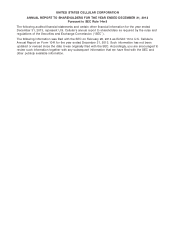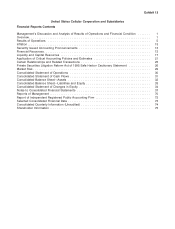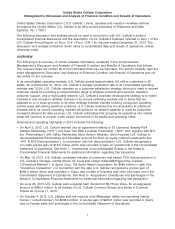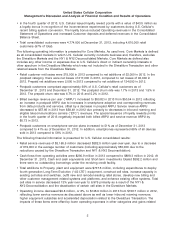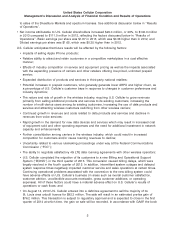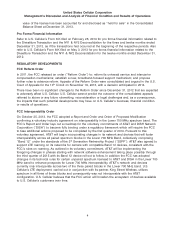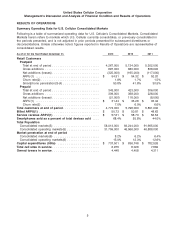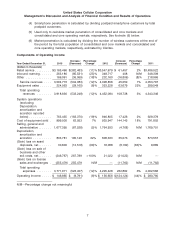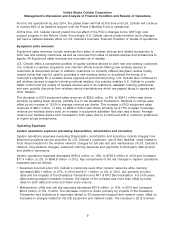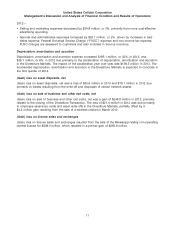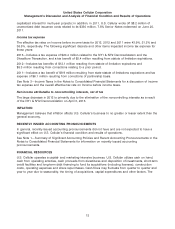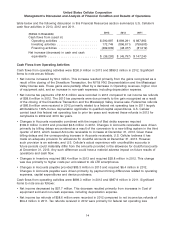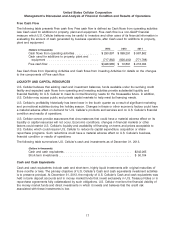US Cellular 2013 Annual Report Download - page 17
Download and view the complete annual report
Please find page 17 of the 2013 US Cellular annual report below. You can navigate through the pages in the report by either clicking on the pages listed below, or by using the keyword search tool below to find specific information within the annual report.United States Cellular Corporation
Management’s Discussion and Analysis of Financial Condition and Results of Operations
Fund is not operational by July 2014, the phase down will halt at that time and U.S. Cellular will continue
to receive 60% of its baseline support until the Phase II Mobility Fund is operational.
At this time, U.S. Cellular cannot predict the net effect of the FCC’s changes to the USF high cost
support program in the Reform Order. Accordingly, U.S. Cellular cannot predict whether such changes
will have a material adverse effect on U.S. Cellular’s business, financial condition or results of operations.
Equipment sales revenues
Equipment sales revenues include revenues from sales of wireless devices and related accessories to
both new and existing customers, as well as revenues from sales of wireless devices and accessories to
agents. All Equipment sales revenues are recorded net of rebates.
U.S. Cellular offers a competitive portfolio of quality wireless devices to both new and existing customers.
U.S. Cellular’s customer acquisition and retention efforts include offering new wireless devices to
customers at discounted prices; in addition, customers on currently offered rate plans receive loyalty
reward points that may be used to purchase a new wireless device or accelerate the timing of a
customer’s eligibility for a wireless device upgrade at promotional pricing. U.S. Cellular also continues to
sell wireless devices to agents including national retailers; this practice enables U.S. Cellular to provide
better control over the quality of wireless devices sold to its customers, establish roaming preferences
and earn quantity discounts from wireless device manufacturers which are passed along to agents and
other retailers.
The decrease in 2013 equipment sales revenues of $29.2 million, or 8%, to $324.1 million was driven
primarily by selling fewer devices, partially due to the Divestiture Transaction. Declines in volume were
offset by an increase of 12.0% in average revenue per device. The increase in 2012 equipment sales
revenues of $63.7 million, or 22%, to $353.2 million was driven primarily by a 17% increase in average
revenue per wireless device sold; an increase in equipment activation fees also was a factor. Average
revenue per wireless device sold increased in both years due to a continued shift in customer preference
to higher priced smartphones.
Operating Expenses
System operations expenses (excluding Depreciation, amortization and accretion)
System operations expenses (excluding Depreciation, amortization and accretion) include charges from
telecommunications service providers for U.S. Cellular’s customers’ use of their facilities, costs related to
local interconnection to the wireline network, charges for cell site rent and maintenance of U.S. Cellular’s
network, long-distance charges, outbound roaming expenses and payments to third-party data product
and platform developers.
System operations expenses decreased $183.4 million, or 19%, to $763.4 million in 2013 and increased
$17.4 million, or 2%, to $946.8 million in 2012. Key components of the net changes in System operations
expenses were as follows:
• Expenses incurred when U.S. Cellular’s customers used other carriers’ networks while roaming
decreased $64.1 million, or 27%, in 2013 and $11.1 million, or 4%, in 2012, due primarily to lower
rates and the impacts of the Divestiture Transaction and NY1 & NY2 Deconsolidation. For both years,
data roaming usage increased; however, the impact of the increase was more than offset by lower
rates for both data and voice and lower voice volume.
• Maintenance, utility and cell site expenses decreased $61.6 million, or 15%, in 2013 and increased
$24.4 million, or 6%, in 2012. The decrease in 2013 is driven primarily by impacts of the Divestiture
Transaction and reductions in expenses related to 3G equipment support and network costs, offset by
increases in charges related to 4G LTE equipment and network costs. The increase in 2012 is driven
9


